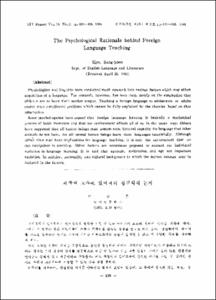국내 항만정책의 분석 연구
- Alternative Title
- An Analysis Study of Domestic Harbour Planning Policy
- Abstract
- 우리나라는 지난 20여년 간 너무나 急速한 經濟成長을 거치면서 持續的인 對外 指向的 經濟成長을 推進해왔다. 이러한 急速한 經濟成長을 이루면서 그 배후에는 港灣施設이 가장 중요한 役割을 하였다고 할 수 있을 것이다. 그러나 고도의 經濟成長을 거치면서 港灣施設의 확보는 너무나도 미흡하였고 港灣施設의 확충을 위한 政府의 投資 또한 經濟成長에 비하여 미흡하였다. 그 실 예로 外國의 경우 GNP대비 投資率 면에서 일본이 0.34%, 대만이 0.5%인데 비해서 우리 나라는 92년 0.15%에 불과한 실태이다.
우리 나라의 施設부족을 보면 1991년 全國의 港灣 物動量은 4억 1,318만 1천톤이며 이중에서 施設所要貨物量(油類貨物量 제외)은 2억 7,663만 1천톤으로서 荷役能力 2억 5,635만 2천톤에 비해 1,927만 9천톤이다. 이러한 施設부족은 계속 增加하여 2001년에 釜山港의 경우 2,581만 8천톤 仁川港은 3,792만 7천톤 光陽港은 5,517만 4천톤, 그리고 蔚山港의 경우 2,438만 4천톤의 施設부족을 보일 것으로 예상이 된다.
따라서 本 論文에서는 外國의 投資實態 및 港灣施設, 荷役能力, 그리고 항만지원시설등을 살펴보고 政府의 港灣 開發 政策을 진단하고자 한다.
현재 우리 나라는 2001년까지 전구 主要港灣에서의 적체현상을 대폭완화하고 2011년까지 완전 해소한다는 목표를 가지고 있다. 그 대표적인 예가 新港灣 開發 計劃이다. 인천 북항, 보령 新港灣, 새만금 新港灣, 목포 신외항, 부산 가덕도 新港灣, 蔚山 新港灣, 포항영일만 新港 등 7개항이다. 항만의 개발은 막대한 투자를 요구하기 때문에 개발의 경제적 타당성이 우선적으로 고려되어야 하며, 정치적 고려에 의한 지역 안배나 Two Port System과 같은 단순 논리의 개념은 배제 되어야 한다.
또한 港灣은 단 순한 荷役 場所가 아닌 快適하고 親環境的인 綜合港灣空間으로 造成이 되어야 한다. 따라서 단순한 荷役만을 目的으로 하는 港灣이 아닌 친수공간, 종합물류단지, 금융 및 정보통신, 국제회의장, 무역센터기능 등을 부여하는 등 體系的이고 普遍的인 港灣開發이 요구된다.
The reapid economic growth of Korea for the past few decades could not have been achieved without the promotion of international trades including export of commodity goods and oversea construction services. For the promotion of exports good harbor facilities must play an important role, but it is found that the investment on harbor facilities of Korea has been insufficient compared with those of competing countries, such as Japan and Taiwan.
In 1991 the overall figure of loading/unloading volume was 413,181,000 tons, among which 276,631 ton needed loading/unloading facilities other than pipe lines for petrochemical products. Compared with the figure 256,352 ton, the total loading/unloading capacity at that time, lack of harbor facilities turned up 19,279 ton per annum.
This work aims at examining the harbor development policies of the port authority of Korea and a brief investigation into the current status of harbor facilities of some other countries.
The targets set by Korean government are 1) to reduce delay of loading/unloading substantially by 2001 and 2) to completely resolve the problem of delaying loading/unloading operation. For these purposes they have plans to build new ports all over the coasts including North-Inchon, Samangum, New-Mokpo, Gaduckdo, New-Ulsan and Youngilman.
The reapid economic growth of Korea for the past few decades could not have been achieved without the promotion of international trades including export of commodity goods and oversea construction services. For the promotion of exports good harbor facilities must play an important role, but it is found that the investment on harbor facilities of Korea has been insufficient compared with those of competing countries, such as Japan and Taiwan.
In 1991 the overall figure of loading/unloading volume was 413,181,000 tons, among which 276,631 ton needed loading/unloading facilities other than pipe lines for petrochemical products. Compared with the figure 256,352 ton, the total loading/unloading capacity at that time, lack of harbor facilities turned up 19,279 ton per annum.
This work aims at examining the harbor development policies of the port authority of Korea and a brief investigation into the current status of harbor facilities of some other countries.
The targets set by Korean government are 1) to reduce delay of loading/unloading substantially by 2001 and 2) to completely resolve the problem of delaying loading/unloading operation. For these purposes they have plans to build new ports all over the coasts including North-Inchon, Samangum, New-Mokpo, Gaduckdo, New-Ulsan and Youngilman.
- Issued Date
- 1998
- Type
- Research Laboratory
- Alternative Author(s)
- Kim, Seong-deuk; Whang, Jong-tae
- Publisher
- 공학연구논문집
- Language
- kor
- Rights
- 울산대학교 저작물은 저작권에 의해 보호받습니다.
- Citation Volume
- 29
- Citation Number
- 2
- Citation Start Page
- 191
- Citation End Page
- 219
- Appears in Collections:
- Research Laboratory > Engineering Research
- 파일 목록
-
-
Download
 000002025585.pdf
기타 데이터 / 434.65 kB / Adobe PDF
000002025585.pdf
기타 데이터 / 434.65 kB / Adobe PDF
-
Items in Repository are protected by copyright, with all rights reserved, unless otherwise indicated.